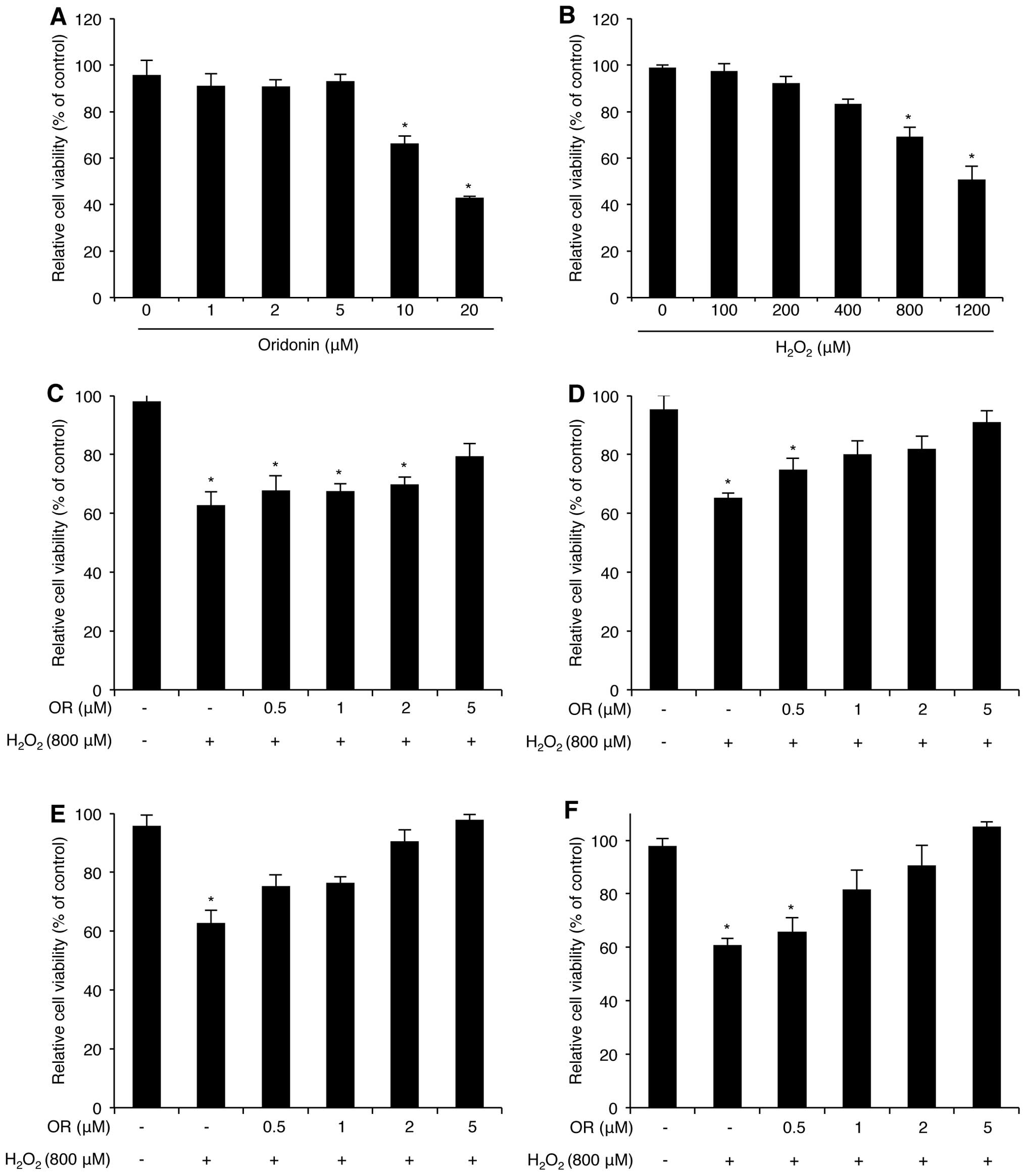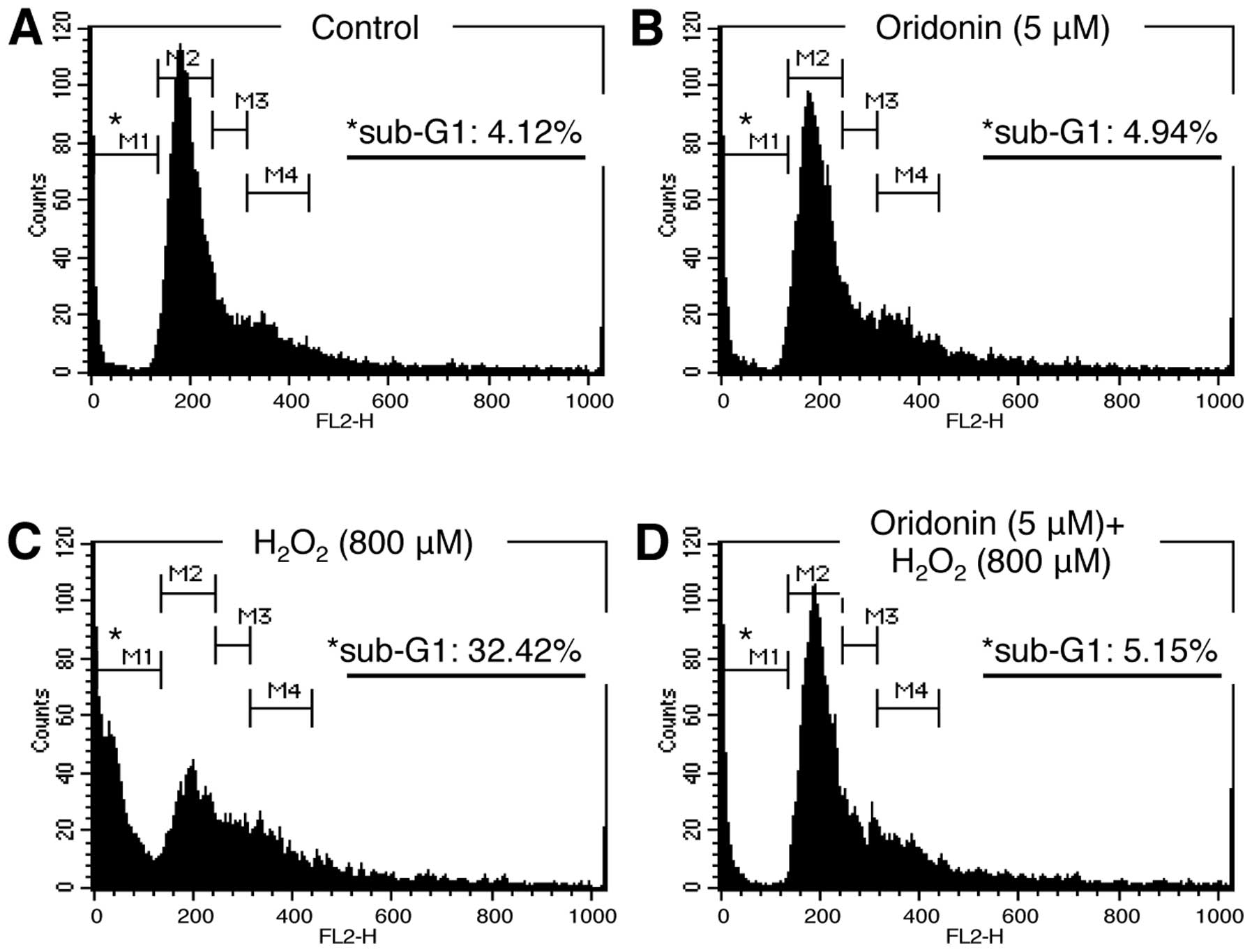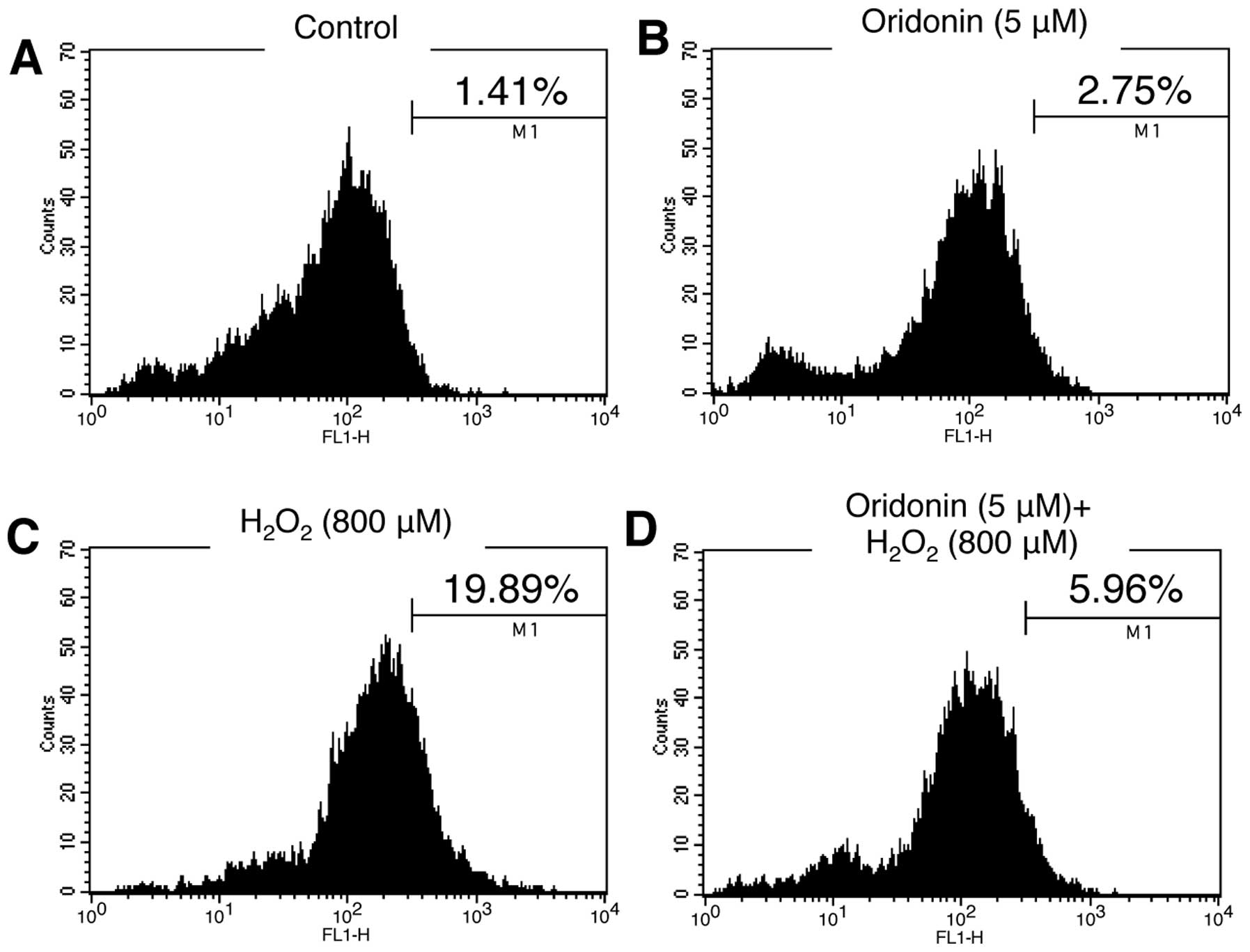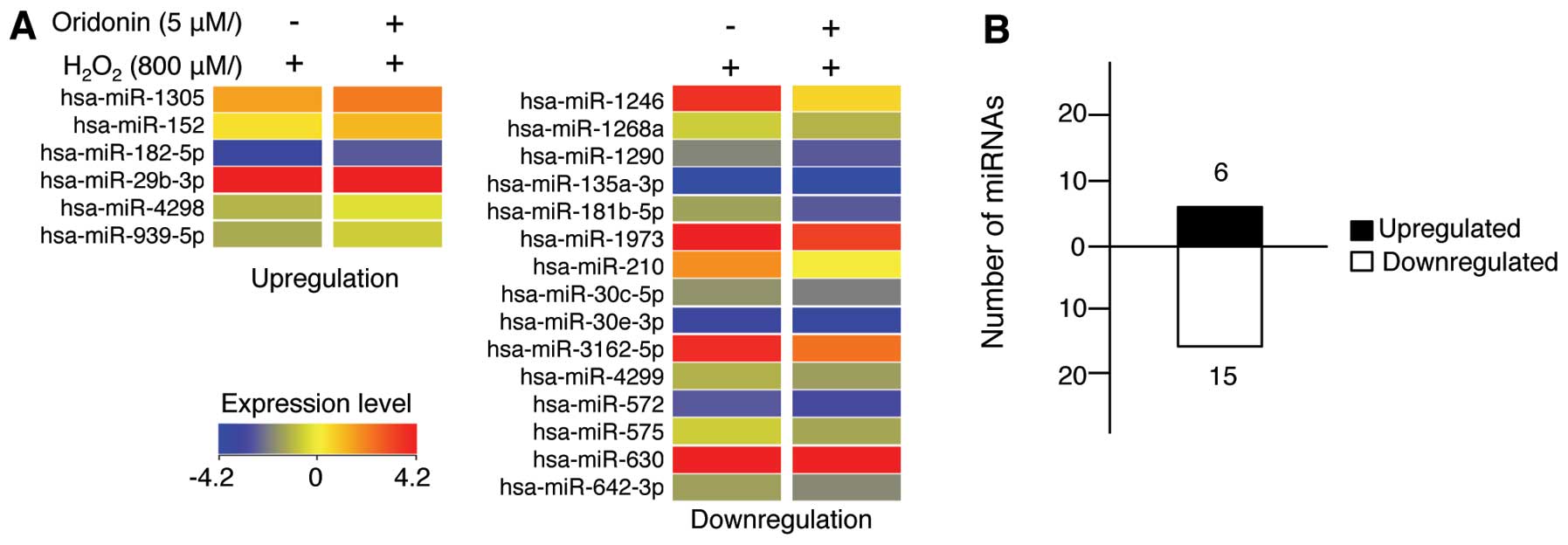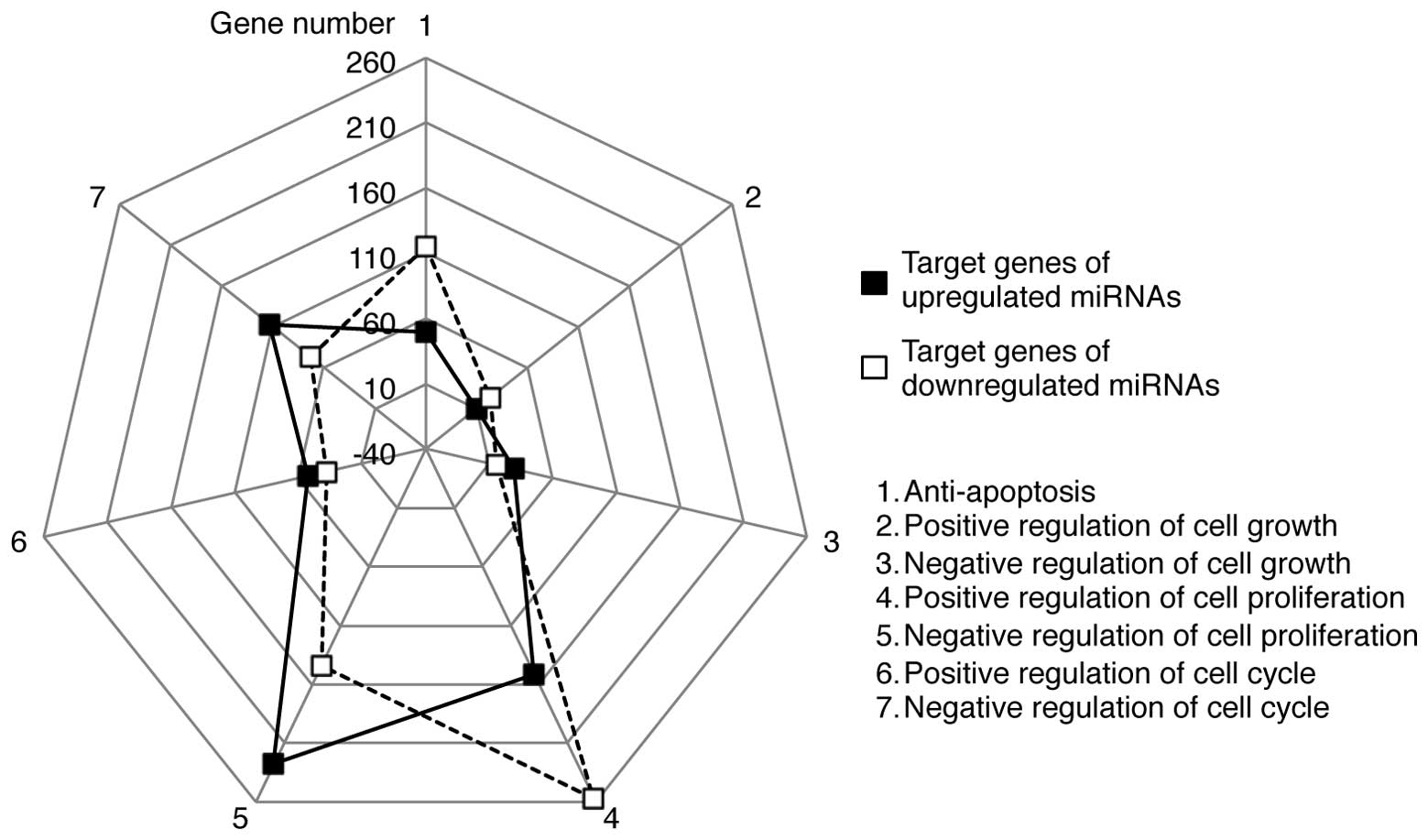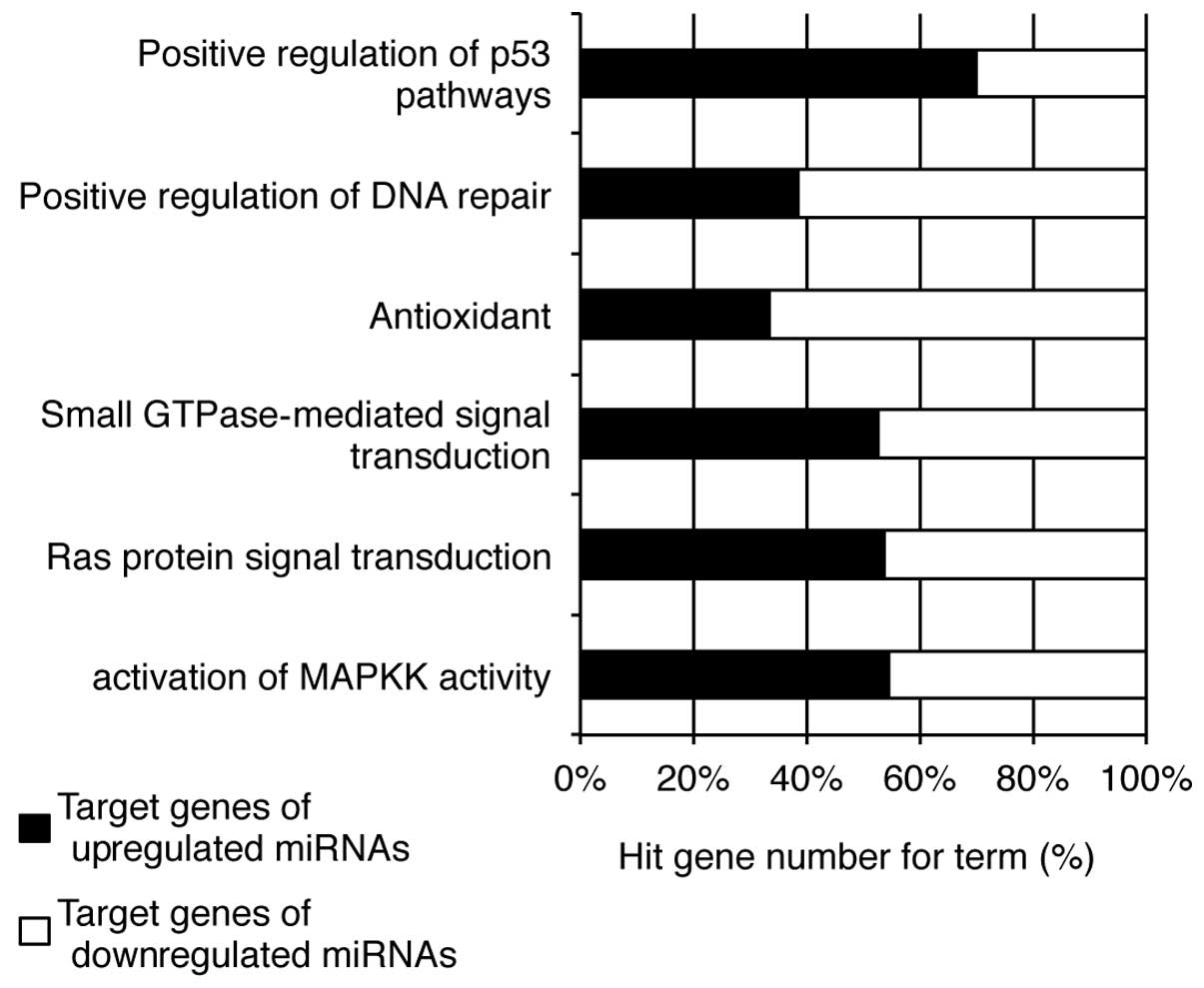Oridonin protects HaCaT keratinocytes against hydrogen peroxide-induced oxidative stress by altering microRNA expression
- Authors:
- Published online on: November 19, 2013 https://doi.org/10.3892/ijmm.2013.1561
- Pages: 185-193
Abstract
Introduction
Human keratinocytes compose the outermost layer of the skin, and are the predominant cells found in the epidermis. Due to their localization in the human body, keratinocytes are continuously exposed to endogenous and environmental pro-oxidant agents. Therefore, the levels of intracellular hydrogen peroxide (H2O2) increase in response to a variety of pro-oxidant agents (e.g., UV radiation and sunlight), free ions liberated from storage and heme-containing proteins (1,2). Epidermal cells and keratinocytes of normal skin are the primary targets of pro-oxidant agents, and thus express high levels of cellular proteins related to the detoxification of reactive oxygen species (ROS) (1). These increased levels are implicated in certain inflammatory skin diseases, such as psoriasis, and are mediated by oxidative stress (3). Therefore, increased ROS production and defects in the antioxidant system may be involved in the pathogenesis of keratinocyte-related diseases (4).
Recently, a number of studies have reported that microRNAs (miRNAs) play important roles in the regulation of functions of keratinocytes. Biswas et al (5) first reported the association between miRNAs and keratinocyte proliferation by demonstrating that miR-210 attenuates keratinocyte proliferation by downregulating the cell cycle regulatory gene, E2F3. Moreover, Yu et al (6) revealed that miR-205 promotes keratinocyte migration through the downregulation of SH2-containing phosphoinositide 5′-phosphatase 2 (SHIP2), a lipid phosphatase that dephosphorylates a critical cell survival factor, termed phosphatidylinositol 3,4,5-triphosphate (PIP3). Furthermore, Hildebrand et al (7) identified an association between miRNAs and keratinocyte differentiation by profiling miRNA expression during human keratinocyte differentiation. miRNAs have also been linked to psoriasis, a disease characterized by abnormal keratinocyte proliferation. More specifically, miR-125a and miR-424 are downregulated in the skin of patients with psoriasis. These miRNAs modulate keratinocyte proliferation by targeting fibroblast growth factor receptor 2 (FGFR2), and putatively target mitogen-activated protein kinase kinase 1 (MEK1) and cyclin E1 (8,9). We recently reported that the titrated extract of Centella asiatica protects HaCaT keratinocytes from UVB-induced cytotoxicity by altering miRNA expression (10). Despite these studies demonstrating that miRNAs are key regulators in diverse biological processes in human keratinocytes, the association between ROS and miRNAs in these cells remains unclear.
Oridonin, a diterpenoid isolated from Rabdosia rubescens, has been shown to exhibit anticancer, anti-microbial, and anti-inflammatory properties (11). Although increased ROS production has been implicated in the anticancer effects of oridonin (12,13), studies have revealed that this effect does not occur in normal cells (14). In fact, oridonin has been shown to exert protective effects against arsenic(III)-induced oxidative stress (15). These data indicate that the oridonin-mediated regulation of ROS production varies by cell type. In the present study, we demonstrate that oridonin reduces ROS production and exerts protective effects against H2O2-induced damage in HaCaT keratinocytes. Furthermore, we used miRNA microarray and bioinformatics tools to elucidate the molecular mechanisms that mediate these protective effects against oxidative stress.
Materials and methods
Cell culture and chemical treatment
Normal human HaCaT keratinocytes were grown in Dulbecco’s modified Eagle’s medium (DMEM; Gibco®, Life Technologies, Carlsbad, CA, USA) supplemented with 10% fetal bovine serum (FBS; Sigma-Aldrich, St. Louis, MO, USA) and antibiotics. Oridonin and H2O2 were purchased from Sigma-Aldrich and Merck (Darmstadt, Germany), respectively. For toxicity and cell viability assays, 4×104 HaCaT cells per well were seeded into 96-well plates and 7×105 cells were seeded into 60-mm culture plates, respectively. Oridonin and H2O2 were diluted into DMSO (Sigma-Aldrich) and deionized water, respectively. The cells were treated with various doses of oridonin and a fixed dose (800 μM) of H2O2 for 3–24 h. Propidium iodide (PI) and Triton X-100 were purchased from Sigma-Aldrich.
Cell viability assay
The effects of oridonin on the growth of HaCaT cells treated with or without H2O2 were assessed using water-soluble tetrazolium salt (WST-1) assays. After treatment, the HaCaT cells were mixed with 100 μl of WST-1 solution followed by incubation at 37°C for 1 h. Cell viability was determined after measuring the absorbance at 450 nm using an iMark microplate reader (Bio-Rad Laboratories, Hercules, CA, USA). All results are expressed as the mean percentage ± standard deviation (SD) of 3 independent experiments. When comparing treated and untreated cells, p-values <0.05 as determined by the Student’s t-test were considered to indicate statistically significant differences.
ROS scavenging assay
Intracellular ROS scavenging assays were performed by measuring the fluorescence intensity of the 2′7′-dichlorofluroescein diacetate (DCF-DA) probe, which was proportional to the amount of ROS formed. The cells pre-treated with and without oridonin were incubated with H2O2 for 3 h prior to harvest. The cells were then mixed with DCF-DA solution and incubated at 37°C for 1 h. Fluorescence intensity was measured using a BD FACSCalibur flow cytometer (BD Biosciences, San Jose, CA, USA).
Analysis of cell death by flow cytometry
Cell cycle and death were estimated by assessing the incorporation of the fluorescent dye, PI. Cells treated with and without oridonin and/or H2O2 were harvested, resuspended, and then incubated with PI staining solution (50 μg/ml PI, 0.5% Triton X-100, and 100 μg/ml RNase) at 37°C for 1 h. Fluorescence intensity was detected using a BD FACSCalibur flow cytometer.
miRNA-based microarray analysis
Total RNA was isolated using TRIzol reagent (Invitrogen, Life Technologies) according to the manufacturer’s instructions. RNA integrity, concentration and purity were estimated using an Agilent 2100 Bioanalyzer (Agilent Technologies, Santa Clara, CA, USA) and MaestroNano (Maestrogen, Las Vegas, NV, USA). RNA samples that exhibited A260/280 and A260/A230 values >1.8, as well as an RNA integrity number (RIN) >8.0, were subjected to microarray analysis, which was performed using SurePrint G3 Human V16 miRNA 8×60 K arrays (Agilent Technologies) according to a previously described protocol (16). Derived data were analyzed using GeneSpring GX software, version 11.5 (Agilent Technologies). The raw data were filtered using Flag and t-tests. miRNA expression was evaluated by assessing the fluorescence ratio between 2 samples. Those displaying >1.5-fold increase or decrease were selected for further bioinformatics analysis.
Computational analysis of miRNAs
To investigate the biological functions of miRNAs that exhibited significant changes in expression, we identified their putative target genes using MicroCosm Targets, version 5 (www.ebi.ac.uk/enright-srv/microcosm/htdocs/targets/v5/). The cellular functions of the target genes were then determined using AmiGO, a Gene Ontology (GO)-based analysis and categorization tool (amigo.geneontology.org/cgi-bin/amigo/browse.cgi).
Results
Oridonin reduces H2O2-induced cytotoxicity in HaCaT cells
Prior to investigating the protective effects of oridonin on H2O2-induced cellular stress, we first determined the dose range of oridonin that causes cytotoxicity in HaCaT cells. The HaCaT cells were treated with various concentrations of oridonin (1–20 μM) for 24 h, and cytotoxicity was estimated using the WST-1 assay (Fig. 1A). Cell viability was maintained at doses between 1 to 5 μM; however, higher concentrations of oridonin (10 and 20 μM) decreased HaCaT cell viability. We also determined that HaCaT cell viability decreased following treatment with H2O2 in a dose-dependent manner (Fig. 1B). As we were concerned about the combined effects of H2O2 and oridonin on HaCaT cytotoxicity, the cells were pre-treated with various doses of oridonin for different periods of time prior to the induction of oxidative stress with H2O2. Cell viability was analyzed using the WST-1 assay. Surprisingly, the oridonin-pre-treated HaCaT cells exhibited a marked resistance to H2O2-mediated cytotoxicity (Fig. 1C–F). In fact, this effect increased in a concentration and time-dependent manner, suggesting that oridonin exerts a protective effect against H2O2-induced oxidative stress in HaCaT cells.
H2O2-induced HaCaT cell death is reduced following treatment with oridonin
We subsequently investigated the biological mechanisms involved in the protective effects of oridonin against H2O2-induced oxidative stress. Changes in cell viability can be physiologically related to cell cycle arrest and cell death. Therefore, we examined cell cycle progression by PI staining and flow cytometry. The HaCaT cells treated as indicated in Fig. 2 were collected, fixed, stained with PI solution, and subsequently analyzed by flow cytometry. Our data demonstrated that the distribution of cells across the various stages of the cell cycle was similar between the oridonin-treated and the control (DMSO-treated) cells, confirming that treatment with 5 μM oridonin was non-cytotoxic (Fig. 2A and B). By contrast, the percentage of cells in the sub-G1 phase was much higher in the H2O2-treated HaCaT cells compared with the untreated and oridonin-treated cells (Fig. 2C). Nevertheless, this increase was not observed in the HaCaT cells pre-treated with oridonin prior to the induction of oxidative stress (Fig. 2D). These results suggest that treatment with oridonin maintains cell viability by reducing HaCaT cell death in H2O2-induced oxidative stress.
Treatment with oridonin decreases H2O2-induced ROS production
H2O2 is well established as a strong inducer of ROS, which, if present at high levels, promote cell death. Since oridonin is a diterpenoid compound, and some diterpenoid compounds have been shown to have antioxidant properties, we examined the possibility that oridonin acts as a ROS scavenger. HaCaT cells grown in oridonin-containing medium were treated with H2O2 for 3 h. Following exposure to H2O2, the cells were stained with DCF-DA solution and the levels of ROS were then analyzed by flow cytometry. Unlike treatment with H2O2, oridonin alone did not induce significant ROS production in the HaCaT cells (Fig. 3A and C). Of note, our results demonstrated that the increased ROS production induced by H2O2 was reduced to the levels of the controls following treatment with oridonin (Fig. 3D), indicating that oridonin has a scavenging effect on ROS produced in response to H2O2 in HaCaT cells.
Oridonin alters miRNA expression profiles in H2O2-treated HaCaT cells
Since miRNAs have been reported to regulate almost every biological process, including development, differentiation, proliferation and apoptosis (17–19), we sought to determine the effects of oridonin on miRNA expression in HaCaT cells treated with H2O2 for 24 h. A total of 21 miRNAs were differentially expressed following treatment with oridonin (Fig. 4 and Table I). More specifically, 6 miRNAs were upregulated while 15 miRNAs were downregulated. These results indicate that, although the majority of miRNAs did not exhibit significant changes in expression, treatment with oridonin still affected the miRNA expression levels in the HaCaT cells exposed to H2O2.
Table ImiRNAs whose expression was altered following treatment with oridonin in H2O2-exposed HaCaT cells. |
Bioinformatics analysis of miRNAs affected by treatment with oridonin
The miRNAs that exhibited altered expression levels following treatment with oridonin are likely involved in the the cellular mechanisms responsible for the protective effects of oridonin against H2O2-induced oxidative stress in HaCaT cells. Therefore, we used the miRbase Target Database tool, MicroCosm, to identify the putative target genes of these miRNAs. We then determined the biological functions associated with the target genes by GO analysis using AmiGO. Finally, the target genes were grouped according to biological processes. Our data demonstrated that the target genes of the differentially expressed miRNAs could be categorized into 4 groups, namely aging, skin development, apoptosis and cell proliferation (Tables II and III).
Table IIPredicted targets of miRNAs which were upregulated in response to treatment with oridonin in H2O2-exposed HaCaT cells. |
Table IIIPredicted targets of miRNAs which were downregulated in response to treatment with oridonin in H2O2-exposed HaCaT cells. |
The GO terms contained bi-directional processes for each term. For example, ‘apoptosis’ included both anti-apoptotic and pro-apoptotic processes. Therefore, we further categorized the target genes into subsets of GO terms, such as anti-apoptosis and positive or negative regulation of the cell cycle, cell growth and cell proliferation (Fig. 5). A greater number of target genes of the upregulated miRNAs was associated with the negative regulation of the cell cycle, growth and proliferation than with the positive regulation of these processes. Conversely, the target genes of the downregulated miRNAs were more biased towards anti-apoptosis and positive regulation of the cell cycle, growth and proliferation. These results suggest that the upregulated miRNAs may potentially target genes involved in cell death, whereas the downregulated miRNAs may regulate genes critical for cell survival. Further categorization of the target genes demonstrated that the upregulated miRNAs may be linked to the positive regulation of p53 pathways and the activation of MAPKK activity, while those targeted by the downregulated miRNAs are associated with antioxidant activity and the positive regulation of DNA repair (Fig. 6). Collectively, these results suggest that the oridonin-mediated protective effects against H2O2-induced damage in HaCaT cells involve changes in the expression of specific miRNAs that regulate cell proliferation and apoptosis.
Discussion
In this study, we demonstrate that the protective effects of oridonin against H2O2-induced damage in HaCaT human keratinocytes occurs through the regulation of miRNA expression. Oridonin, a diterpenoid isolated from Rabdosia rubescens, reportedly exhibits anticancer effects (11). Although some terpenoid compounds are used as antioxidants (20), this property has yet to be confirmed for oridonin. Depending on the dosage, this compound induces bifunctional effects. As previoiusly demonstrated, high doses (≥10 μM) induce apoptosis in several cancer cell types (11,13,21), while low doses (≤5 μM) protect against arsenic(III)-induced cytotoxicity in UROtsa cells (15). Consistent with these studies, we found that cytotoxicity due to treatment with oridonin only occurs at high concentrations (>5 μM). Notably, at non-cytotoxic concentrations, oridonin induced a protective effect on H2O2-induced cell death in HaCaT cells. In addition, DCF-based fluorimetric assay revealed that low doses of oridonin act as a scavenger of ROS during H2O2-induced oxidative stress. Our data suggest that oridonin exerts these effects by altering miRNA expression profiles. Bioinformatics analysis of the putative target genes of the miRNAs revealed that the differentially expressed miRNAs may potentially be involved in the anti-apoptotic and antioxidant effects induced by oridonin in HaCaT cells.
Our miRNA microarray and bioinformatics analysis indicated that the putative target genes of the downregulated miRNAs may be involved in antioxidant processes and the negative regulation of cell proliferation. Of note, miR-210 expression was markedly decreased by oridonin in the H2O2-treated HaCaT cells (Table I). This miRNA has been reported to increase ROS formation in response to hypoxia and to target the iron-sulfur cluster protein, ISCU, in MCF-7 and HCT116 cancer cells (22,23). Moreover, miR-210 is the predominant miRNA activated under hypoxic conditions in various cancer types, and its expression is upregulated by hypoxia-inducible factor (HIF)-1α (24). Hypoxia-induced miR-210 expression has been shown to attenuate keratinocyte proliferation by downregulating the cell cycle regulatory protein, E2F3 (5). Taken together, these data strongly suggest that miR-210 is an important miRNA in ROS-mediated cellular processes; thus, the regulation of its expression is a major strategy in antioxidative defense mechanisms in keratinocytes.
Our investigation also revealed that miR-1246 and miR-181b-5p (also known as miR-181b) expression was downregulated following treatment with oridonin in H2O2-treated HaCaT cells. Recent studies identified miR-1246 as a novel target of p53, p63 and p73 (25), of which p53 and p63 are important regulators of keratinocyte proliferation and differentiation (26,27). miR-181b expression is induced during human keratinocyte differentiation (7). Another study demonstrated that the overexpression of miR-181b induces cisplatin-mediated apoptosis by targeting B-cell lymphoma 2 (BCL2) mRNA (28). Moreover, miR-181 expression has been found to be upregulated in the brain tissue of patients with Alzheimer’s disease, which has been linked to ROS-mediated oxidative stress (29,30). Collectively, these data, as well as ours indicate that miR-1246 and miR-181 are important targets involved in the regulation of ROS-mediated oxidative stress in keratinocytes.
The treatment of HaCaT cells exposed to H2O2 with oridonin also induced an increase in miRNA expression. The expression of miR-182-5p (also known as miR-182) was significantly upregulated in our system, and was predicted to function in anti-apoptotic processes. Indeed, previously published studies have demonstrated a role of miR-182-5p in anti-apoptosis. miR-182-5p enhances melanoma oncogenic behavior and reduces apoptosis by targeting the tumor suppressor genes, forkhead factor O3 (FOXO3) and microphthalmia-associated transcription factor-M (MITF-M) (31). In addition, the overexpression of miR-182-5p has been shown to induce prostate cancer progression by targeting the tumor suppressor genes forkhead box F2 (FOXF2), reversion-inducing cysteine-rich protein with Kazal motifs (RECK) and metastasis suppressor 1 (MTSS1) (32). Furthermore, miR-182-5p overexpression has been shown to markedly induce tumorigenesis and to reduce ionizing radiation (IR)-mediated apoptosis in ovarian cancer cells (33). Similar to these studies, we observed that miR-182-5p expression was significantly higher in the oridonin-pre-treated H2O2-exposed HaCaT cells compared with the control cells treated only with H2O2. Therefore, our results indicate that the oridonin-mediated upregulation of miR-182-5p expression enhances cell growth- and anti-apoptosis-related functions, thus exerting protective effects against oxidative stress and cell death induced by H2O2 in HaCaT cells.
In this study, we provide evidence of the potential role of miRNAs in oridonin-mediated anti-apoptosis in response to H2O2-induced oxidative stress in HaCaT human keratinocytes. Although further research is required to verify the biological significance of these changes in miRNA expression, as well as the target genes of these miRNAs, our study provides a meaningful link between oridonin-induced antioxidative defense mechanims and the regulation of miRNA expression in human keratinocytes.
Acknowledgements
We are grateful to all members of our research group for their support and advice regarding this study. This study was supported by the KU Research Professor Program of Konkuk University and a grant from the Ministry of Science, ICT and Future Planning (Grant 20110028646) of the Republic of Korea.
References
|
Wojas-Pelc A and Marcinkiewicz J: What is a role of haeme oxygenase-1 in psoriasis? Current concepts of pathogenesis. Int J Exp Pathol. 88:95–102. 2007. View Article : Google Scholar : PubMed/NCBI | |
|
Applegate LA, Scaletta C, Panizzon R and Frenk E: Evidence that ferritin is UV inducible in human skin: part of a putative defense mechanism. J Invest Dermatol. 111:159–163. 1998. View Article : Google Scholar : PubMed/NCBI | |
|
Bickers DR and Athar M: Oxidative stress in the pathogenesis of skin disease. J Invest Dermatol. 126:2565–2575. 2006. View Article : Google Scholar : PubMed/NCBI | |
|
Briganti S and Picardo M: Antioxidant activity, lipid peroxidation and skin diseases. What’s new. J Eur Acad Dermatol Venereol. 17:663–669. 2003. | |
|
Biswas S, Roy S, Banerjee J, et al: Hypoxia inducible microRNA 210 attenuates keratinocyte proliferation and impairs closure in a murine model of ischemic wounds. Proc Natl Acad Sci USA. 107:6976–6981. 2010. View Article : Google Scholar : PubMed/NCBI | |
|
Yu J, Peng H, Ruan Q, Fatima A, Getsios S and Lavker RM: microRNA-205 promotes keratinocyte migration via the lipid phosphatase SHIP2. FASEB J. 24:3950–3959. 2010. View Article : Google Scholar : PubMed/NCBI | |
|
Hildebrand J, Rutze M, Walz N, et al: A comprehensive analysis of microRNA expression during human keratinocyte differentiation in vitro and in vivo. J Invest Dermatol. 131:20–29. 2011. View Article : Google Scholar : PubMed/NCBI | |
|
Xu N, Brodin P, Wei T, et al: MiR-125b, a microRNA downregulated in psoriasis, modulates keratinocyte proliferation by targeting FGFR2. J Invest Dermatol. 131:1521–1529. 2011. View Article : Google Scholar : PubMed/NCBI | |
|
Ichihara A, Jinnin M, Yamane K, et al: microRNA-mediated keratinocyte hyperproliferation in psoriasis vulgaris. Br J Dermatol. 165:1003–1010. 2011. View Article : Google Scholar : PubMed/NCBI | |
|
An IS, An S, Choe TB, et al: Centella asiatica protects against UVB-induced HaCaT keratinocyte damage through microRNA expression changes. Int J Mol Med. 30:1349–1356. 2012. | |
|
Tian W and Chen SY: Recent advances in the molecular basis of anti-neoplastic mechanisms of oridonin. Chin J Integr Med. 19:315–320. 2013. View Article : Google Scholar : PubMed/NCBI | |
|
Wang H, Ye Y, Chui JH, et al: Oridonin induces G2/M cell cycle arrest and apoptosis through MAPK and p53 signaling pathways in HepG2 cells. Oncol Rep. 24:647–651. 2010.PubMed/NCBI | |
|
Wang S, Zhong Z, Wan J, et al: Oridonin induces apoptosis, inhibits migration and invasion on highly-metastatic human breast cancer cells. Am J Chin Med. 41:177–196. 2013. View Article : Google Scholar : PubMed/NCBI | |
|
Chen S, Gao J, Halicka HD, Huang X, Traganos F and Darzynkiewicz Z: The cytostatic and cytotoxic effects of oridonin (Rubescenin), a diterpenoid from Rabdosia rubescens, on tumor cells of different lineage. Int J Oncol. 26:579–588. 2005.PubMed/NCBI | |
|
Du Y, Villeneuve NF, Wang XJ, et al: Oridonin confers protection against arsenic-induced toxicity through activation of the Nrf2-mediated defensive response. Environ Health Perspect. 116:1154–1161. 2008. View Article : Google Scholar : PubMed/NCBI | |
|
An IS, An S, Kang SM, et al: Titrated extract of Centella asiatica provides a UVB protective effect by altering microRNA expression profiles in human dermal fibroblasts. Int J Mol Med. 30:1194–1202. 2012. | |
|
Ambros V and Lee RC: Identification of microRNAs and other tiny noncoding RNAs by cDNA cloning. Methods Mol Biol. 265:131–158. 2004.PubMed/NCBI | |
|
Cheng AM, Byrom MW, Shelton J and Ford LP: Antisense inhibition of human miRNAs and indications for an involvement of miRNA in cell growth and apoptosis. Nucleic Acids Res. 33:1290–1297. 2005. View Article : Google Scholar : PubMed/NCBI | |
|
Chen JF, Mandel EM, Thomson JM, et al: The role of microRNA-1 and microRNA-133 in skeletal muscle proliferation and differentiation. Nat Genet. 38:228–233. 2006. View Article : Google Scholar : PubMed/NCBI | |
|
Grassmann J: Terpenoids as plant antioxidants. Vitam Horm. 72:505–535. 2005. View Article : Google Scholar : PubMed/NCBI | |
|
Gao FH, Liu F, Wei W, et al: Oridonin induces apoptosis and senescence by increasing hydrogen peroxide and glutathione depletion in colorectal cancer cells. Int J Mol Med. 29:649–655. 2012.PubMed/NCBI | |
|
Favaro E, Ramachandran A, McCormick R, et al: microRNA-210 regulates mitochondrial free radical response to hypoxia and krebs cycle in cancer cells by targeting iron sulfur cluster protein ISCU. PLoS One. 5:e103452010. View Article : Google Scholar : PubMed/NCBI | |
|
Kim JH, Park SG, Song SY, Kim JK and Sung JH: Reactive oxygen species-responsive miR-210 regulates proliferation and migration of adipose-derived stem cells via PTPN2. Cell Death Dis. 4:e5882013. View Article : Google Scholar : PubMed/NCBI | |
|
Huang X, Ding L, Bennewith KL, et al: Hypoxia-inducible mir-210 regulates normoxic gene expression involved in tumor initiation. Mol Cell. 35:856–867. 2009. View Article : Google Scholar : PubMed/NCBI | |
|
Liao JM, Zhou X, Zhang Y and Lu H: MiR-1246: a new link of the p53 family with cancer and Down syndrome. Cell Cycle. 11:2624–2630. 2012. View Article : Google Scholar : PubMed/NCBI | |
|
Woodworth CD, Wang H, Simpson S, Alvarez-Salas LM and Notario V: Overexpression of wild-type p53 alters growth and differentiation of normal human keratinocytes but not human papillomavirus-expressing cell lines. Cell Growth Differ. 4:367–376. 1993.PubMed/NCBI | |
|
Truong AB and Khavari PA: Control of keratinocyte proliferation and differentiation by p63. Cell Cycle. 6:295–299. 2007. View Article : Google Scholar : PubMed/NCBI | |
|
Zhu W, Shan X, Wang T, Shu Y and Liu P: miR-181b modulates multidrug resistance by targeting BCL2 in human cancer cell lines. Int J Cancer. 127:2520–2529. 2010. View Article : Google Scholar : PubMed/NCBI | |
|
Dumont M and Beal MF: Neuroprotective strategies involving ROS in Alzheimer disease. Free Radic Biol Med. 51:1014–1026. 2011. View Article : Google Scholar : PubMed/NCBI | |
|
Schipper HM, Maes OC, Chertkow HM and Wang E: microRNA expression in Alzheimer blood mononuclear cells. Gene Regul Syst Bio. 1:263–274. 2007.PubMed/NCBI | |
|
Segura MF, Hanniford D, Menendez S, et al: Aberrant miR-182 expression promotes melanoma metastasis by repressing FOXO3 and microphthalmia-associated transcription factor. Proc Natl Acad Sci USA. 106:1814–1819. 2009. View Article : Google Scholar : PubMed/NCBI | |
|
Hirata H, Ueno K, Shahryari V, et al: microRNA-182-5p promotes cell invasion and proliferation by down regulating FOXF2, RECK and MTSS1 genes in human prostate cancer. PLoS One. 8:e555022013. View Article : Google Scholar : PubMed/NCBI | |
|
Liu Z, Liu J, Segura MF, et al: MiR-182 overexpression in tumourigenesis of high-grade serous ovarian carcinoma. J Pathol. 228:204–215. 2012. View Article : Google Scholar : PubMed/NCBI |



